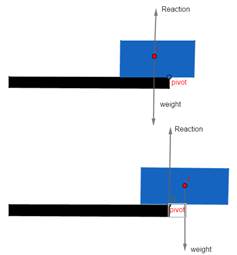A rectangular brick is kept on a table with a part of its length projecting out. It remains at rest if the length projected is slightly less than half the total length but it falls down if the length projected is slightly more than half the total length. Give reason.
When the part projecting out is less than that of its half, the torque about the pivot is not sufficient to make the brick rotate about it. This is an impossible case as the center of mass is still inside the table.

But when the part projecting out is more than that of its half, the center of mass gets projected out and the torque becomes effective as the reaction force is lesser than that of weight. Hence, the brick falls down.
1